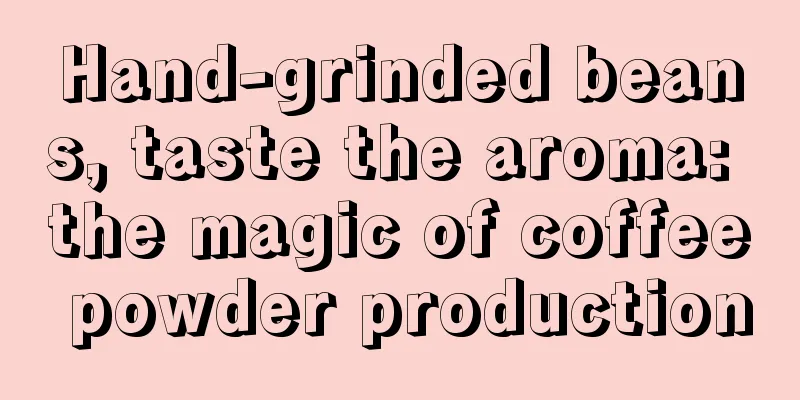Coffee beans: edible poop or delicious treasure?

Coffee beans: edible poop or delicious treasure?Coffee beans are one of the most popular beverages in the world, with hundreds of millions of people enjoying the invigorating aroma and taste every day. However, have you ever thought that there is a dark secret behind these delicacies? Coffee beans may be digested by animals during the growth process and excreted through feces. This has sparked a controversy: whether there is an edible feces called "treasure" in coffee beans. History and traditionFirst, let's look at the historical origins of this question. According to archaeologists, centuries ago, African tribesmen began to collect and process coffee berries excreted by wild animals after digestion. They believed that the berries processed by animal intestines had a better aroma and taste, and regarded them as precious ingredients. Over time, people realized that they could mimic the effects of animal digestion by cultivating specific varieties or using special processing methods. This method became widely used in Asia and South America and gradually became a traditional way of making coffee. Science and practiceHowever, with the advancement of science and technology, people began to conduct in-depth research on this traditional method. They found that the enzymes produced during animal digestion can break down certain harmful substances in coffee beans and make them easier to digest and absorb. In addition, animal intestines can also add some special aroma and flavor to coffee beans. Based on these findings, some farmers have begun to try to process coffee beans by artificially simulating the animal digestion process. They ferment coffee cherries that are not fully ripe or have been dehydrated in a specific environment and control factors such as time and temperature to simulate the conditions in the animal intestine. Quality and tasteSo, are coffee beans treated with feces really of superior quality as the legend goes? The answer is not simple. First of all, let’s be clear: manure processing is not a method used by all coffee producers. In fact, most commercial coffee beans are processed through traditional washed or dry processing. However, some specific brands and farmers still insist on using manure processing to produce special flavored coffee. For those seeking a unique experience and trying something new, coffee processed with feces does have a distinctive flavor profile. It is often rich, smooth, floral, and relatively low in acidity. Ethics and Environmental ProtectionIn addition to quality and taste, there is an even more important issue to consider: ethical and environmental factors. Although the animal digestion process can improve the texture and flavor of coffee beans, this method is also controversial. First, the large-scale use of animal intestines for coffee processing in modern agriculture may lead to animal welfare issues and trigger ethical discussions about whether animals should be used as "production tools." In addition, it also presents certain challenges in terms of environmental protection, as manure treatment requires longer time and additional resources (such as water, energy, etc.). In today's context of global warming and resource shortages, we need to pay more attention to sustainable development and environmentally friendly agriculture. in conclusionIn conclusion, whether coffee beans are made from poop or are delicious treasures depends on personal preference and values. For those who seek unique experiences and try new things, coffee processed from poop can be an exciting and interesting choice. However, when considering factors such as quality, ethics and environmental protection, we should also be cautious about this production method and think about how to protect animal welfare and environmental sustainability while satisfying personal taste needs. |
<<: How many grams of coffee powder can be ground from one coffee bean?
>>: Starbucks coffee bean supplier distribution data revealed
Recommend
Herbal Coffee Planting Guide
Herbal Coffee Planting Guide Herbal coffee is a u...
Can coffee beans be ground using a powder grinder?
Can coffee beans be ground using a powder grinder...
Coffee bean sealed jar, which brand is the best choice?
Coffee bean cans are an important tool for coffee...
The consequences of drinking a large amount of coffee at one time, exploring the effects of excessive coffee intake
Drinking a large amount of coffee at one time may...
Caramel coffee, explore the secret behind the delicious taste
Caramel coffee is a delicious drink with many sec...
A Complete Guide to Starbucks Coffee Varieties and Names
A Complete Guide to Starbucks Coffee Varieties an...
Aroma coffee, taste the pure coffee culture
Aroma coffee: taste the pure coffee culture Coffe...
Ten world-famous coffee bean varieties: a glance
Coffee is one of the most popular drinks in the w...
Nestle coffee machine: the international brand of coffee choice
Nestle coffee machine: the international brand of...
Kudi Coffee: The most delicious coffee you will fall in love with at first sight!
Kudi Coffee: The most delicious coffee you will f...
Cook Coffee: A coffee journey with unique taste and mellow aroma
Cook Coffee: How to use a semi-automatic coffee m...
How to Grind Your Own Coffee Beans
Choosing the right coffee beans for your taste: A...
Uncovering the Secrets of the Shelf Life of Nescafé Bottled Beverages
The secret of the shelf life of Nestle coffee bot...
Nescafé: The perfect combination of quality and aroma
Introduction: The perfect combination of quality ...
Coffee Bean Roasting Degree: New Definition and Development Trend
introduction Coffee is one of the most popular dr...









